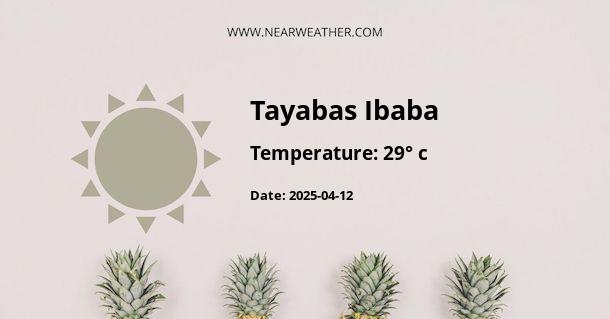Tayabas Ibaba, PH Climate and Weather Year Round
Tayabas Ibaba is a municipality located in the province of Quezon, Philippines. It is known for its rich cultural heritage, historical sites, and picturesque landscapes. Understanding the climate and weather patterns of Tayabas Ibaba is essential for residents and tourists alike. In this article, we will explore the climate and weather conditions of Tayabas Ibaba throughout the year.
Geographical Location
Tayabas Ibaba is situated in the southern part of the Luzon island, specifically in the Calabarzon region. It is bordered by the municipalities of Tayabas City, Lucban, and Sariaya. The town is located near the foothills of the Mount Banahaw and Mount San Cristobal, which greatly influences its climate and weather.
Climate Classification
Tayabas Ibaba falls under the tropical savanna climate classification, characterized by two distinct seasons - the dry season and the wet season. The climate is influenced by the northeast monsoon (amihan) and the southwest monsoon (habagat) that affect the Philippines.
Temperature
The temperature in Tayabas Ibaba remains relatively warm throughout the year, with minor variations between seasons. The average annual temperature ranges from 24 to 32 degrees Celsius (75 to 90 degrees Fahrenheit). The hottest months are April and May, with temperatures reaching up to 35 degrees Celsius (95 degrees Fahrenheit). The coolest months are from December to February, with temperatures dropping to around 21 to 23 degrees Celsius (70 to 73 degrees Fahrenheit).
The table below provides a summary of the average monthly temperatures in Tayabas Ibaba:
| Month | Average Temperature (°C) |
|---|---|
| January | 23 |
| February | 23 |
| March | 24 |
| April | 26 |
| May | 27 |
| June | 27 |
| July | 26 |
| August | 26 |
| September | 25 |
| October | 25 |
| November | 24 |
| December | 23 |
Rainfall
Tayabas Ibaba experiences a pronounced wet season, which typically starts in June and extends until November. During this period, the municipality receives the majority of its annual rainfall. The wettest months are from July to September, with an average monthly rainfall of around 200 to 300 millimeters.
The dry season in Tayabas Ibaba occurs from December to May. The driest months are February and March, with precipitation levels dropping to around 10 to 20 millimeters per month. The table below illustrates the average monthly rainfall in Tayabas Ibaba:
| Month | Average Rainfall (mm) |
|---|---|
| January | 30 |
| February | 10 |
| March | 20 |
| April | 30 |
| May | 60 |
| June | 170 |
| July | 270 |
| August | 250 |
| September | 270 |
| October | 190 |
| November | 140 |
| December | 60 |
Tropical Cyclones
Tayabas Ibaba is occasionally affected by tropical cyclones, also known as typhoons, during the wet season. These cyclones bring heavy rain, strong winds, and can cause flooding and landslides. The peak months for typhoon activity in the Philippines are from July to October.
Humidity
Tayabas Ibaba experiences high humidity levels throughout the year due to its proximity to bodies of water and dense vegetation. The average relative humidity ranges from 70% to 80%.
Conclusion
Tayabas Ibaba has a tropical savanna climate characterized by a dry and wet season. The temperature remains warm throughout the year, with minor variations between seasons. The wet season extends from June to November, with the peak of rainfall occurring from July to September. The dry season lasts from December to May, with February and March being the driest months. Residents and visitors should be aware of the weather patterns in Tayabas Ibaba to plan their activities and make necessary preparations.
A - Tayabas Ibaba's Latitude is 13.616670 & Longitude is 122.266670.
A - Weather in Tayabas Ibaba is 26° today.
A - Climate Conditions in Tayabas Ibaba shows overcast clouds today.
A - Humidity in Tayabas Ibaba is 87% today.
A - Wind speed in Tayabas Ibaba is 4.57 km/h, flowing at 34° wind direction. today.
